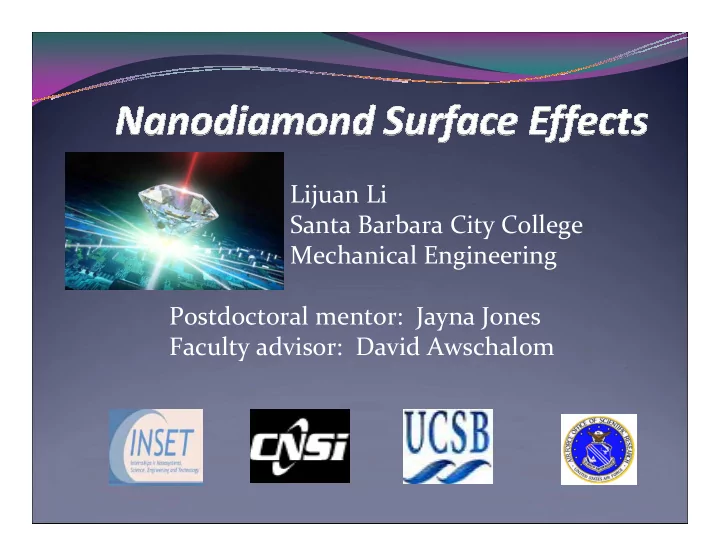

Lijuan Li Santa Barbara City College Mechanical Engineering Postdoctoral mentor: Jayna Jones Faculty advisor: David Awschalom
Why nanodiamonds? Electron spin Carbon Properties Biocompatibility & nontoxicity Chemical stability nitrogen Fluorescence from its defects Potential applications Vacancy Single particle tracking Cellular biomarkers (tumor targeting and cell imaging) http://awsch-web.physics.ucsb.edu/research/solid_state/polarization/d2_figure_01.jpg
Problems Background noise complicates experiments Suspect they come from surface(50nm~100nm diamond has large surface area to volume ratio)
Goals Create a method to approximate � nanodiamond concentration � Surface cleaning � Study of surface charge properties
Concentration vs absorption Dilution Run absorption scan using UV ‐ vis spectrophotometer Analyze the absorption as a function of concentration Develop a method of figuring out the concentration of a nanodiamond solution easily UV-vis spectrophotometer
Linear fit data of absorption vs concentration 4.5 4.0 Abs@300nm 3.5 Abs@350nm Abs@400nm =26.948*(concentration) - 0.01603 Absorption (a.u.) Abs@400nm 3.0 Abs@450nm Abs@488nm 2.5 Abs@500nm 2.0 1.5 1.0 0.5 0.0 0.00 0.02 0.04 0.06 0.08 0.10 Concentration(weight%)
Surface cleaning Acetone Centrifuge treatment nanodiamond Rinse with millipore water and centrifuge the sample. Repeat 3 ‐ 4 times Resuspend treated nanodiamond in water for experiments
After surface treatment � Excitation at 532nm � Emission scan with fluorimeter � Fluorescence comparison Cary Eclipse Fluorimeter � Fluorimeter vs UV ‐ vis spectrophotometer Fluorimeter UV ‐ vis spectrophotometer Measures the light that is emitted Measures how much light being from the sample, which is called absorbed by the sample fluorescence
Emission scan at 532nm The fluorescent peaks of the washed nanodiamond are sharper than the untreated 0.05wt% untreated one washed 0.05wt% Intensity(a.u.) 10 1 600 650 700 750 800 Wavelength(nm)
Emission scan at 532nm untreated 0.025wt% washed 0.025wt% The untreated nanodiamond has a sharper peak Intensity (a.u.) 10 1 600 650 700 750 800 Wavelength(nm)
What is zeta potential? � Measures the amount of surface charge � Potential between the diffuse layer and fixed layer is zeta potential � Factors •Speed of particle •Strength of E field •Distance between the electrodes http://nition.com/en/products/zeecom_s.htm
Zeta potential vs pH Surface charge varies with pH Acetone wash does not change the surface charge a -12 lot -14 zeta potential(mV) -16 -18 -20 untreated ND -22 -24 acetone washed ND -26 -28 -30 -32 -34 -36 -38 -40 2 3 4 5 6 7 8 9 10 measured pH
Future studies � Clean the nanodiamonds with strong acid at high temperature � Study if the surface charge properties affects the fluorescence of nanodiamonds through the emission scan with different pH in solution
Acknowledgements � Mentor: Jayna Jones � Advisor: David Awschalom � Fellow INSET students and advisors � Funding source: U.S. Air Force � Reference: “ Detonation nanodiamonds as UV radiation filter” “The particle size ‐ dependent photoluminescence of nanodiamonds”
Energy band diagram Red region
Nanodiamond in solution
Nanodiamonds photobleaching Fluorescence (counts per millisecond) 100 80 60 40 0 600 1200 1800 2400 3000 Time (s) � Laser: 160mW, 532 nm � Photobleaching is the photochemical destruction of a fluorophore. In microscope, photobleaching may complicate the observation of fluorescent molecules, since they will eventually be destroyed by the light exposure necessary to stimulate them into fluorescing. This is especially problematic in time ‐ lapse microscopy.
Equation of zeta potential µe= 2 ε ζ f(Ka)/ 3 η • µe=the electrophoretic mobility (µ/s)/(V/cm) • ζ = zeta Potential (mV) • ε = dielectric constant of the medium • η = viscosity of the medium • F(ka)=Function of particle radius
Light spectrum http://www.dnr.sc.gov/ael/personals/pjpb/lecture/spectrum.gif
Questions � How is the orientation of spin relate to intensity of fluorescence? Does it relate to the energy band? � Why single photon emission results in high resolution imaging in application
Recommend
More recommend